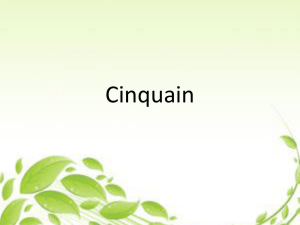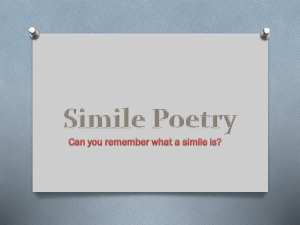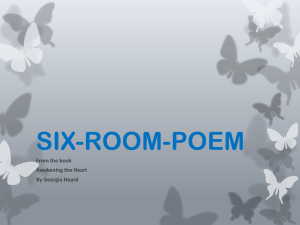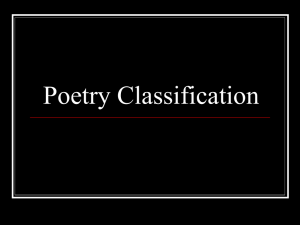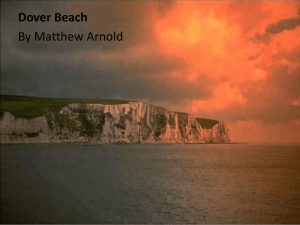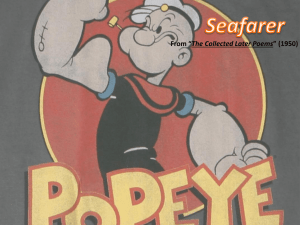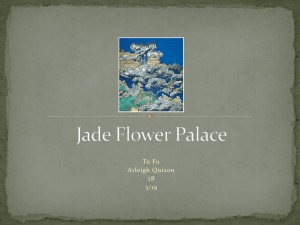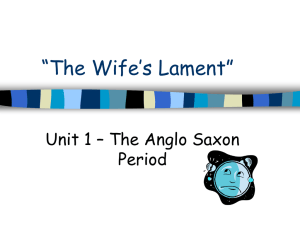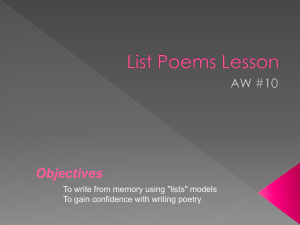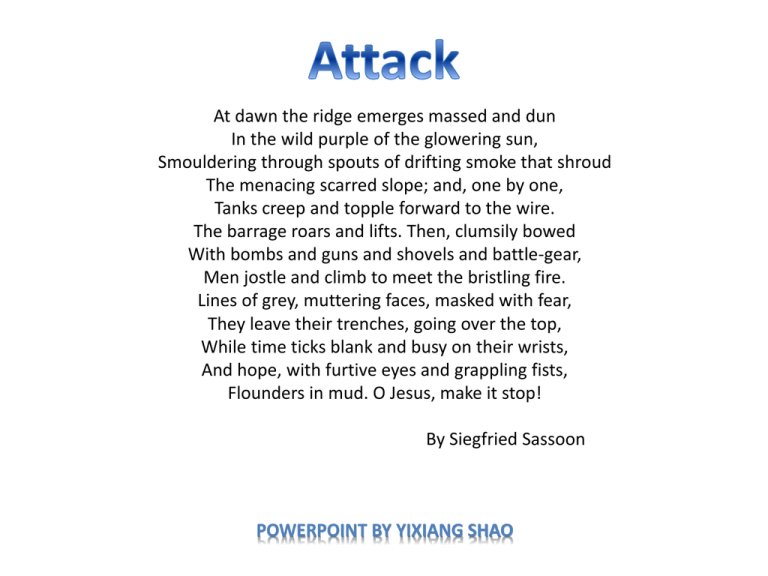
At dawn the ridge emerges massed and dun
In the wild purple of the glowering sun,
Smouldering through spouts of drifting smoke that shroud
The menacing scarred slope; and, one by one,
Tanks creep and topple forward to the wire.
The barrage roars and lifts. Then, clumsily bowed
With bombs and guns and shovels and battle-gear,
Men jostle and climb to meet the bristling fire.
Lines of grey, muttering faces, masked with fear,
They leave their trenches, going over the top,
While time ticks blank and busy on their wrists,
And hope, with furtive eyes and grappling fists,
Flounders in mud. O Jesus, make it stop!
By Siegfried Sassoon
POWERPOINT BY YIXIANG SHAO
“Siegfried Sassoon is best known for his poetry of the First World War, which communicates the
horror and futility of warfare.”
This is demonstrated in this poem as the poet evokes vivid, bleak imagery of the struggle of war.
From the first reading alone the reader is able to interpret Sassoon’s way of communicating his
thoughts of warfare, and is given an effective insight of war directly from the front line.
The title of the poem itself is blunt and shows signs of aggression; directly reinforcing the poem’s
content of the grim warfare.
The poem is not split into separate stanzas, but is comprised of one single 13-lined stanza. This lack of
structure conveys a sense of crowdedness and chaos; further emphasised by subtle yet powerful
phrases. “Tanks creep and topple forward” is an example of this, which displays the clumsiness and is
intertwined with a sense of fear as the battle commences; “The barrage roars and lifts”. “Tanks creep
and topple forward” further gives a sense of anticipation; as the tanks slowly advance the soldiers
prepare to meet the opposition and gamble their lives; “Men jostle and climb to meet the bristling fire”.
There is a lack of a distinct narrator, which widens the effect of the poem to a much broader view; it is
not limited to only the eyes of a specific narrator.
There is no specific rhythm within the poem, as the poem instead focuses more on imagery.
Alliteration and assonance of “scarred slope” gives emphasis on the effects and consequences of war.
It conveys the detrimental consequences of war through the use of the landscape as a means of
linking the idea to the soldiers and everyone else affected by war.
Other words which develop assonance are also present; “Smouldering through spouts of drifting
smoke that shroud” builds and conveys further the consequences of war.
The language used to describe both the landscape and the soldiers provide a solemn, fearful
atmosphere. Adjectives such as “glowering”, “menacing”, “creep and topple”, “jostle and bristling” all
help to create a hushed yet tense mood; which all correspond to the nature of warfare.
The poem starts with dawn, where the “glowering sun” shines its “wild purple” and the “ridge
emerges massed and dun”. This signifies the beginning of the battle, and the use of the rising sun
evokes a sense of solemnity, as the sun- which often signifies hope and warmth- shows no positivity
as it only brings with it chaos and suffering.
“While time ticks blank and busy on their wrists” shows the passing of time as the soldiers fire their
guns and fend off the enemy. Time is described as a dull continuance; “ticks blank” as the soldiers are
only concerned with the battle, and so time is of no significance to them.
Hope is personified in the final lines of the poem “And hope, with furtive eyes and grappling fists,
flounders in mud”. This verse is an important aspect of the poem as it shows the diminishing hope,
struggling to be seen-through its comparison to flounders in mud.
“O Jesus, make it stop!” holds significance, as the narrator begs for war to stop, turning to religion in
times of chaos.
The poem has an abundance of imagery; most of which are bleak and colourless;
“wild purple of the glowering sun” does not convey positivity, but rather a dark hue which suggests of
a dreary atmosphere.
“smouldering through spouts of drifting smoke” shows an unclear, almost choking, setting which
engulfs the soldiers.
“lines of grey, muttering faces, masked with fear” produces a clear image of the faces of the soldiers,
and conveys and further emphasises the bleak mood in which war sets on people.
Many images produced show menacing aspects of war; “scarred slope” suggests sharpness and
relentlessness, whilst “the barrage roars and lifts” conveys loudness and chaos.
A strong, clear image is produced with the personification of hope; “furtive eyes and grappling fists,
flounders in mud” as it evokes a sense of hopelessness, in which hope struggles and fights to show
itself-possibly in the hearts of the soldiers, but the crack of the gunfire may be drowning out its cries
to be seen.

